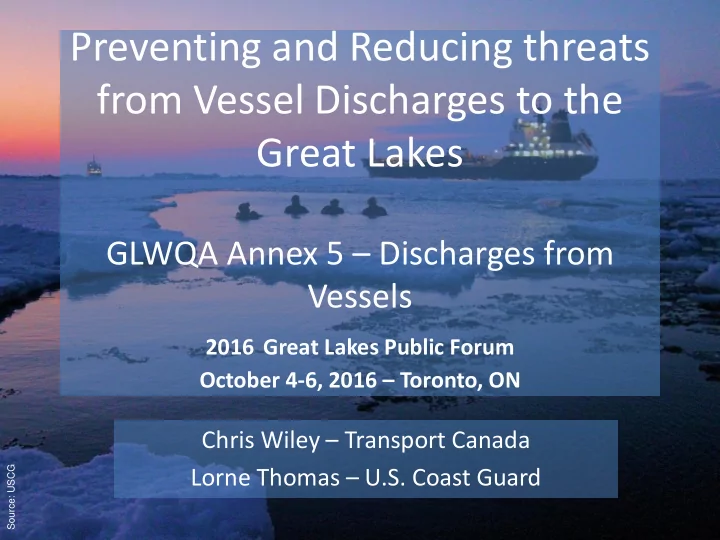

Preventing and Reducing threats from Vessel Discharges to the Great Lakes GLWQA Annex 5 – Discharges from Vessels 2016 Great Lakes Public Forum October 4-6, 2016 – Toronto, ON Chris Wiley – Transport Canada Source: USCG Lorne Thomas – U.S. Coast Guard
Annex 5 - Discharges from Vessels Annex 5 Purpose Purpose of this Annex is to contribute to the achievement of the General and Specific Objectives of this Agreement by preventing and controlling vessel discharges that are harmful to the quality of the Waters of the Great Lakes, through the adoption and implementation of regulations, programs, and other measures that facilitate coordinated and cooperative implementation and enforcement, where appropriate. 2
Annex 5 - Discharges from Vessels Background • 1972 / 78 / 87 protocols of the Source: TC GLWQA focused on oil and chemical discharges • Appropriate for concerns of the time Source: TC • Regional regulatory regime • Minimal preparedness and response capabilities 3
Annex 5 - Discharges from Vessels Background Since 1987 WQA Protocol, significant increase in international ship safety and pollution prevention conventions, laws and regulations • SOLAS • PWSA 1972 • CSA 2001 • MARPOL • PTSA 1978 • Domestic • STCW • OPA 1990 Regulations to • CSC • NISA 1996 Implement IMO • COLREGS • MTSA 2002 Conventions 4
Annex 5 - Discharges from Vessels Background • Both Parties have ratified or provided equivalency to international marine pollution conventions • Accompanying increase in pollution prevention, preparedness, responsibility, compensation and response Reflected in direction of 2012 GLWQA Protocol • • Convention on Intervention on the High Sea 1969 • London Ocean Dumping Convention 1972 • Convention on Oil Pollution Preparedness, Response & Cooperation 1990 • Convention on Anti-Fouling System on Ships 2001 • Convention on Control & Management of Ship’ Ballast Water & Sediments 2004 • Bilateral Joint Marine Pollution Contingency Plan between the U. S. and Canada - Great Lakes Geographic Annex (CANUSLAK) - Joint Response Team 5
Annex 5 - Discharges from Vessels Progress Source: USCG • Canadian and U.S. flag state inspections and port state control examinations of foreign-flag vessels ensured compliance Source: USCG • Prevention-focused programs have reduced risk of pollution to very low levels; including garbage & sewage • Swift and effective response regime in place to Source: USCG mitigate impact of any pollution stemming casualties or accidents 6
Annex 5 - Discharges from Vessels Progress • Since GLWQA’s 1987 Protocol, ballast water-mediated Source: DFO invasions of aquatic nuisance species became greatest risk from vessels Source : USCG • TC, USCG and St Lawrence Seaway Corps comprehensive enforcement of BW exchange requirements for ships entering the GL from outside EEZ. No aquatic invasive species attributed to ballast water discharge since joint program Source: DFO implemented in 2006. • USCG BW discharge standard, EPA Vessel General Permit and Canada’s forthcoming implementation of IMO BW Management Convention necessitate cooperation & coordination 7
Annex 5 - Discharges from Vessels Priorities for Action - 2017-2019 • Seek consistency and compatibility between U.S. and Canada during implementation of USCG ballast water discharge standard, EPA’s Vessel General Permit requirements and development of regulations implementing IMO BW Management Convention. Working together, with stakeholders towards compatible, fair, practicable and • environmentally protective Great Lakes requirements for ballast water management. Priority for Science - 2017-2019 • Develop compatible approaches to sampling and analysis of ships ballast water in connection with the ballast water performance standard in 33 CFR Part 151 and Regulation D-2 of the International Convention for the Control and Management of Ship’ Ballast Water and Sediments 2004. 8
Recommend
More recommend